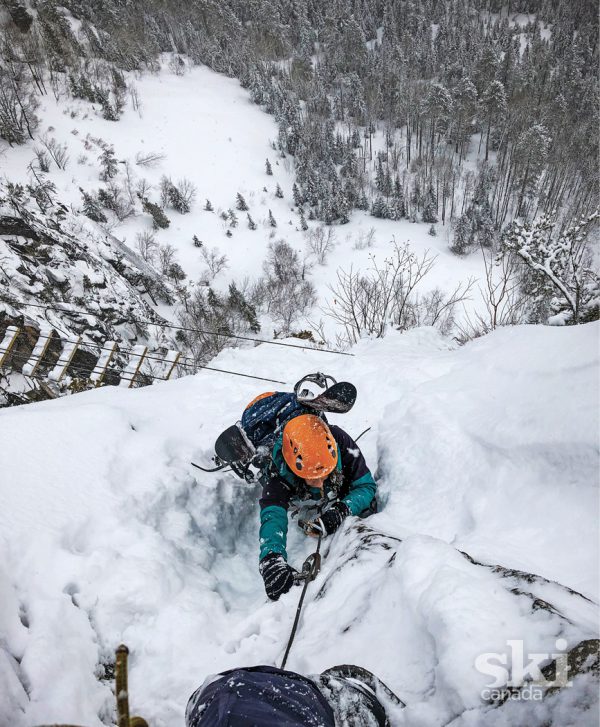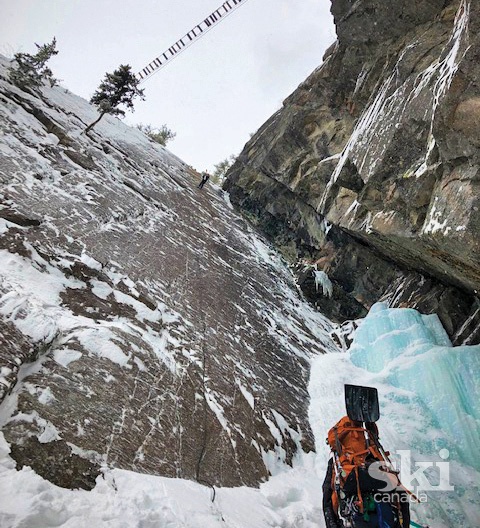Head to Quebec’s Iron Road, Via Ferraski, at Palissades de Charlevoix.
I’ve earned my fair share of turns over the years, but never quite like this. The first half of the new Via Ferraski unfolds much like any other guided backcountry tour. Up and up our group of five climbs as fat flakes blanket the Palissades de Charlevoix wilderness park near Saint-Siméon, Quebec.
Our 400-vertical-metre ascent of the park’s namesake escarpment is eased by the considerable efforts of Étienne Leblanc, the younger of our two guides, who is breaking trail on snowshoes. The rest of us follow behind on wide, stubby Altai Hok skis provided by the park. The built-in skins grip the fresh powder well enough, and the Nordic-style bindings do likewise to my toes. My heels, however, move freely enough to facilitate a few faceplants during the occasional short descents. Still, this setup proves ideal for negotiating the dozens of tight switchbacks that give Sasha, a German guest on a longer split-snowboard, no end of trouble.
Our group offers encouragement, and chuckles a bit, as Sasha, smiling and cursing, catches a tip on yet another pine sapling. Little do we know that he will soon have the last laugh.
The Palissades’ 950m-long route of steel cables, rungs and other climbing aids was said to be North America’s first via ferrata when it opened in 2002. Now, according to the park’s mountaineer founder, François-Guy Thivierge, it’s the first on the continent to welcome skiers, snowshoers and winter-booted hikers. “I’ve climbed everywhere, so I knew these cliffs would be perfect for a via ferrata,” he explains, gesturing toward the four-km-long granite wall beside us. “People love it when there’s no snow, so I said, ‘Why not in winter, too?’”
François-Guy pauses as if waiting for an answer, then abruptly exclaims, “It is the most spectacular…in America!” It would not be the last time we would hear this phrase over the next three hours.

By the time we reach a rustic cliff-top shelter halfway along the route, our surroundings’ spectacular credentials have been firmly established. Swirling snowflakes settle on proffered banana bread as we gaze out over the meandering Rivière Noire. Far below, ice-covered Lac Jean is home to dual ziplines in spring, summer and fall. Across the valley, François-Guy tells us, Mont des Américains is renowned among backcountry skiers, who often warm up on the lift-serviced off-piste terrain at Le Massif de Charlevoix ski resort an hour’s drive south of my gorgeous digs at the Fairmont Le Manoir Richelieu. There’s also the snow-blessed Mont-Édouard ski area, 45 minutes to the north, which is home to three sections of backcountry terrain, including the 15-hectare Vallée des Géants, or Valley of Giants.
The wintry scene is eye-catching, to be sure, but what about the via ferrata? Is it really “the most spectacular in America”? Hell, does the thing even exist? In addition to confusing Sasha and his girlfriend, Angie—“Isn’t Canada different from America?”—François-Guy’s bold claim has yet to be substantiated.
We continue along the undulating mountaintop, past towering stands of rare red pines, until we reach the top of the “iron road” (which is what “via ferrata,” an Italian term, means in English). From our backpacks we pull helmets and dual-carabiner-equipped harnesses, one of which is always attached to the steel cables that run the length of the route. We stuff our skis and telescopic poles into our packs—again, the stubbiness pays off—while Sasha lashes down the two halves of his board.
Here, again, Étienne more than earns his paycheque. Sliding along the snow-covered cables ahead of us, the curly-haired Québécois uses a shovel to clear a path for his three charges and his boss. I clip on and proceed. As gravity sends me sprawling down the steep, rocky slope, the many snow-fort battles of my youth spring to mind. That is, until a swirling veil of snow parts just enough to reveal a sheer rock face below me.
It doesn’t take long to fall into a rhythm of searching for support, clipping my free carabiner to the next length of cable, unclipping from the previous line and scrambling along the zigzagging descent. I round a hard right turn and suddenly, there in front of me, is the vertiginous footbridge to end all vertiginous footbridges. I stop dead in my tracks, which allows François-Guy to catch up and deafeningly proclaim in my ear, “It is the most spectacular…in America!”
This time his point hits home. I gingerly slide down to a rocky platform next to the bridge’s first wooden rung, and look across the 60m-deep chasm just as Étienne reaches the far side.
François-Guy strolls past me, clips both carabiners onto the cables running parallel to the bridge’s wire railings and casually steps out over the abyss. The tension evident in his guests’ wide eyes is defused by another “It is the most spectacular…in America!”—the proclamation is now comical—and as I clip onto the cables I look up and see Étienne hard at work atop the adjacent cliff. Below him, a single line of rope sways back and forth against the rock face.
I glance back at Angie, whose face has turned as white as our surroundings, and tilt my head in Étienne’s direction. “I’m not sure, but I think that’s the rappel.”
Angie swears loudly in German, then laughs and adds, “It is the most spectacular…in America!”
Gripping the railings as though my life depends on it—which technically it doesn’t, thanks to my harness—I step out onto the first snowy slat. Not only is it slippery, but its neighbours are spaced so widely and unevenly that every step feels like a leap of faith. Despite my best efforts to focus on the task at hand, my eyes are inexorably drawn to the bottom of the gorge. In short, the footbridge was clearly built by masochists.
Dozens of shaky steps and German expletives later, our group wishes Étienne good luck as he heads down what does turn out to be the rappel. Much unwinding, unclipping, clipping and winding later, it’s my turn to hop-moonwalk down the 70m cliff.

I reach the bottom only to find Étienne chatting with a 20-something skier who’s clinging, barnacle-like, to the cliff opposite. “I am just waiting to say ‘Hi’ to you guys,” he explains. Once we’re all assembled he winks at Angie, detaches from the rock, and on his snowshoes absolutely destroys the powder-choked chute atop which we stand. Sasha emits a loud “Whoop!”, quickly assembles his splitboard and does likewise.
If he chuckled as I joined the Hok skiers in sliding down on our bums, he hid the last laugh admirably well.
IF YOU GO
GETTING THERE: The Charlevoix region is a two-hour drive northwest of Quebec City’s Jean Lesage International Airport. The city’s central train station is about 20 minutes closer.
FAIRMONT LE MANOIR RICHELIEU: Right next to the Casino de Charlevoix in La Malbaie on the scenic north shore of the already brackish St. Lawrence River, this historic luxury hotel is home to 405 guest rooms, a full-service spa and four restaurants, including the superb Table et Terroir. Rates start at $179 a night. fairmont.com
PALISSADES DE CHARLEVOIX: The Via Ferraski experience in Saint-Siméon costs $79 a person for groups of at least four. aventurex.net/palissadesdecharlevoix
LE MASSIF DE CHARLEVOIX: Halfway between Quebec City and La Malbaie in Petite-Rivière-Saint-François, Le Massif’s 770m vertical drop is the highest in North America east of the Rocky Mountains. lemassif.com
MONT-ÉDOUARD: A 635m vertical meets more than six metres of annual snowfall at Mont-Édouard in L’Anse-Saint-Jean. montedouard.com



